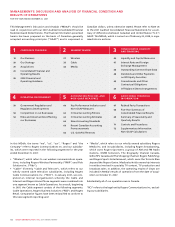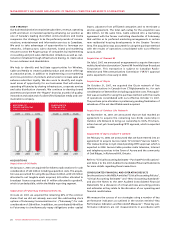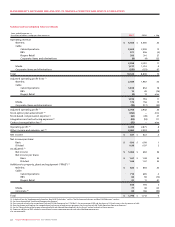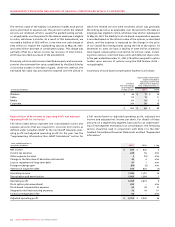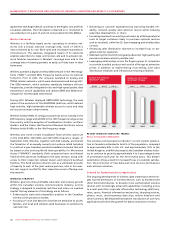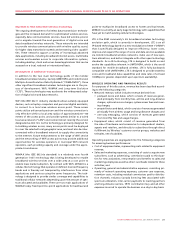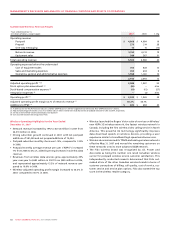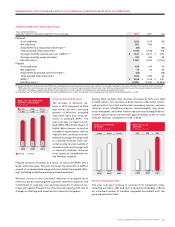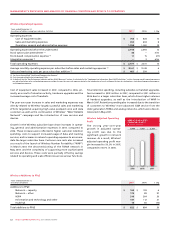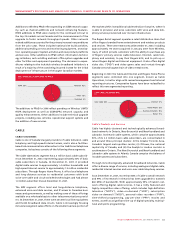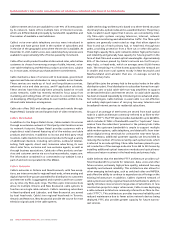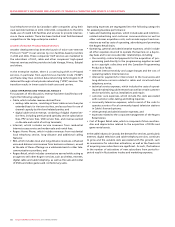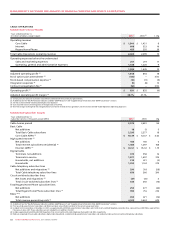Rogers 2007 Annual Report Download - page 32
Download and view the complete annual report
Please find page 32 of the 2007 Rogers annual report below. You can navigate through the pages in the report by either clicking on the pages listed below, or by using the keyword search tool below to find specific information within the annual report.
28 ROGERS COMMUNICATIONS INC. 2007 ANNUAL REPORT
MANAGEMENT’S DISCUSSION AND ANALYSIS OF FINANCIAL CONDITION AND RESULTS OF OPERATIONS
agreement with Rogers Retail, as well as on the Rogers.com and Fido
e-business websites. The information contained in or connected to
our websites is not a part of and not incorporated into this MD&A.
Wireless Networks
Wireless is a facilities-based carrier operating its wireless net-
works over a broad, national coverage area, much of which is
interconnected by its own fibre-optic and microwave transmission
infrastructure. The seamless, integrated nature of its networks
enables subscribers to make and receive calls and to activate net-
work features anywhere in Wireless’ coverage area and in the
coverage area of roaming partners as easily as if they were in their
home area.
Wireless operates a digital wireless GSM network in the 1900 mega-
hertz (“MHz”) and 850 MHz frequency bands across its national
footprint. Prior to 2002, the company operated on analog and
TDMA cellular networks, which were decommissioned during 2007.
The GSM network, which operates seamlessly between the two
frequencies, provides integrated voice and high-speed packet data
transmission service capabilities and utilizes GPRS and EDGE tech-
nologies for wireless data transmission.
During 2007, Wireless deployed UMTS/HSPA technology, the next
phase of the evolution of the GSM/EDGE platform, which delivers
high mobility, high bandwidth wireless access for voice and data
services across major urban centres.
Wireless holds 25 MHz of contiguous spectrum across Canada in the
850 frequency range and 60 MHz in the 1900 frequency range across
the country, with the exception of southwestern Ontario, northern
Québec, and the Yukon, Northwest and Nunavut territories, where
Wireless holds 50 MHz in the 1900 frequency range.
Wireless also holds certain broadband fixed wireless spectrum
in the 2300 MHz, 2500 MHz and 3500 MHz frequency ranges. In
September 2005, Wireless, together with Bell Canada, announced
the formation of an equally-owned joint venture called Inukshuk
to construct a pan-Canadian wireless broadband network that will
be based on the evolving World Interoperability for Microwave
Access (“WiMAX”) standards. Both companies have contributed
fixed wireless spectrum holdings to the joint venture, along with
access to their respective cellular towers and network backhaul
facilities. The fixed wireless network acts as a wholesale provider
of capacity to each of the joint venture partners, who in turn mar-
ket, sell, support and bill for their respective service offerings over
the network.
WIRELESS STRATEGY
Wireless’ goal is to drive profitable subscriber and revenue growth
within the Canadian wireless communications industry, and its
strategy is designed to maximize cash flow and return on invested
capital. The key elements of its strategy are as follows:
•Enhancing its scale and competitivepositioninthe Canadian
wireless communications market;
•Focusingonvoiceanddataservicesthatareattractivetoyouth,
families, and small and medium-sized businesses to optimize its
customer mix;
•Deliveringoncustomerexpectationsbyimprovinghandsetreli-
ability, network quality and customer service while reducing
subscriber deactivations, or churn;
•Increasingrevenuefromexistingcustomersbyutilizinganalytical
tools to target customers likely to purchase optional services
such as voicemail, caller line ID, text messaging and wireless data
services;
•Enhancingsalesdistributionchannelstoincreasefocusontar-
geted customer segments;
•Maintainingthemosttechnologicallyadvanced,highqualityand
pervasive wireless network possible; and
•LeveragingrelationshipsacrosstheRogersgroupofcompanies
to provide bundled product and service offerings at attractive
prices, in addition to implementing cross-selling, joint sales
distribution initiatives and infrastructure sharing initiatives.
RECENT WIRELESS INDUSTRY TRENDS
Focus on Customer Retention
The wireless communications industry’s current market penetra-
tion in Canada is estimated to be 61% of the population, compared
to approximately 84% in the U.S. and approximately 121% in the
United Kingdom, and Wireless expects the Canadian wireless indus-
try to continue to grow by approximately 4 to 5 percentage points
of penetration each year for the next several years. This deeper
penetration drives a need for increased focus on customer satisfac-
tion, the promotion of new data and voice services and features
and customer retention.
Demand for Sophisticated Data Applications
The ongoing development of wireless data transmission technolo-
gies has led developers of wireless devices, such as handsets and
other hand-held devices, to develop more sophisticated wireless
devices with increasingly advanced capabilities, including access
to e-mail and other corporate information technology platforms,
news, sports, financial information and services, shopping services,
photos, music, and streaming video clips, mobile television and
other functions. Wireless believes that the introduction of such new
applications will drive the growth for data transmission services.
20072006
$72.21$67.27$63.56
200
6
2007
WIRELESS POSTPAID
MONTHLY ARPU
($)
2005
20072006
1.15%1.32%1.61%
WIRELESS POSTPAID
MONTHLY CHURN
(%)
200
6
2007
2005


